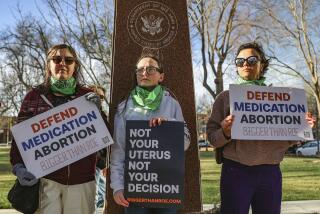Covis Pharma’s statement to The Times about Makena
The following combines several statements from Covis Pharma sent via email. It has been organized for clarity.
Covis Pharma’s response:
Makena is the only FDA-approved therapy to reduce the risk of preterm birth in women with a history of spontaneous preterm birth and its safety profile for the mother and baby are well established. As such, Covis is focused on additional research to further demonstrate the efficacy of Makena and to preserve continued, affordable access for indicated patients.
The current regulatory status pertains specifically to conflicting efficacy data, as the product’s safety was confirmed in both the original clinical trial [known as the Meis trial] that resulted in the accelerated approval and in the subsequent confirmatory trial.
The drug Makena doesn’t reduce the risk of preterm birth, a study found, and the FDA recommended it be taken off the market. Its maker has refused.
17P is the only FDA-approved class of branded and generic treatments to help prevent the risk of preterm birth in women with a history of spontaneous preterm birth, and the totality of data on 17P and the branded version Makena supports its continued positive benefit-risk profile and the need for continued patient access.
Given that Makena rapidly became the standard of care in the U.S. following its approval based on the results of the Meis trial, it became infeasible to enroll high-risk patients in the U.S. in a placebo-controlled confirmatory clinical trial. It was therefore necessary to enroll patients outside of the U.S. in the confirmatory trial, called PROLONG. As a result, the demographics of enrolled patients in PROLONG were significantly different from those enrolled in the U.S.-based Meis trial, including an overall lower risk of preterm birth (in both the placebo and treatment arms).
More specifically, Meis enrolled 59% U.S. black women while PROLONG only enrolled 6.6% U.S. black women. PROLONG patient population was overwhelmingly made up of white European women. The relevance of the difference in demographics is the social determinants of health and therefore the different level of preterm birth risk each group may be subject to.
While both trials demonstrated a positive safety profile for 17P, Meis — which had a diverse, U.S.-based participant population — and PROLONG — which had an overwhelmingly white, lower-risk European participant population — showed different efficacy results.
In 2020, preterm birth and its complications were the second-largest contributor to infant death across the country, disproportionately affecting people of color who are continually underrepresented in clinical studies.
We’re committed to helping providers and indicated patients access Makena and the Makena Care Connection supports patients by connecting eligible patients to prescription support and financial assistance. Since 2018, ~115,000 patients have been directed to Makena Care Connection by their physicians. In addition, under Covis’ ownership, Covis has reduced the net price of Makena for its payer and state purchasers, which is reflective of Covis’ commitment to making Makena accessible to at-risk patients.
We note that the $700 price per dose is not accurate and the actual price per dose for most payers and states is significantly less.
Covis has urged the FDA to allow for further study within the U.S. health care system to understand which, if any, populations may benefit most from 17P. We are pleased that the FDA has granted our request for a hearing to address these critical issues.
Covis is unable to comment on activities conducted by AMAG Pharmaceuticals prior to Covis’ ownership, including any comments made at the FDA Advisory Committee meeting in 2019.
Regarding the study by the Public Health Institute in Oakland that found a cancer risk: Excluding the formulation, this study offers no comparison to Makena, the only FDA-approved therapy to reduce the risk of preterm birth in women with a history of singleton spontaneous preterm birth, nor does it distinguish between an earlier version of the drug introduced in the 1950s to treat a different patient population for a different purpose. Current clinical guidance remains unchanged, as noted by the American College of Obstetricians and Gynecologists, which has stated that “due to limitations in the design, the study’s findings are not conclusive and should not influence practice.”
We can also refer you to the following materials for more background on 17P:
• “Role of progestogens in women at risk for spontaneous preterm birth: the final word?” Ibrahim SA, Haas DM. Lancet; 397:1158-1159. (2021)
• “Safety review of hydroxyprogesterone caproate in women with a history of spontaneous preterm birth” Sibai B, Saade GR, AF Das AF, Gudeman J. J Perinatol. (2020)
• “Re-examining the Meis Trial for Evidence of False-Positive Results” Sibai B, Saade GR, Das AF. Obstet Gynecol; 136(3):622-627. (2020)
• ACOG Statement on 17p Hydroxyprogesterone Caproate (2019)
• “17-OHPC to Prevent Recurrent Preterm Birth in Singleton Gestations (PROLONG Study): A Multicenter, International, Randomized Double-Blind Trial” Blackwell SC et al. J Perinatol; 37(2):127-136. (2019)
• “4-Year follow-up of children exposed to 17alpha hydroxyprogesterone caproate (17P) in utero” Northern A. Am J Obstet Gynecol; 195(6,56). (2006)
• “Prevention of Recurrent Preterm Delivery by 17 Alpha-Hydroxyprogesterone Caproate” Meis PJ et al., N Engl J Med; 348:2379-2385. (2003)
More to Read
Inside the business of entertainment
The Wide Shot brings you news, analysis and insights on everything from streaming wars to production — and what it all means for the future.
You may occasionally receive promotional content from the Los Angeles Times.







